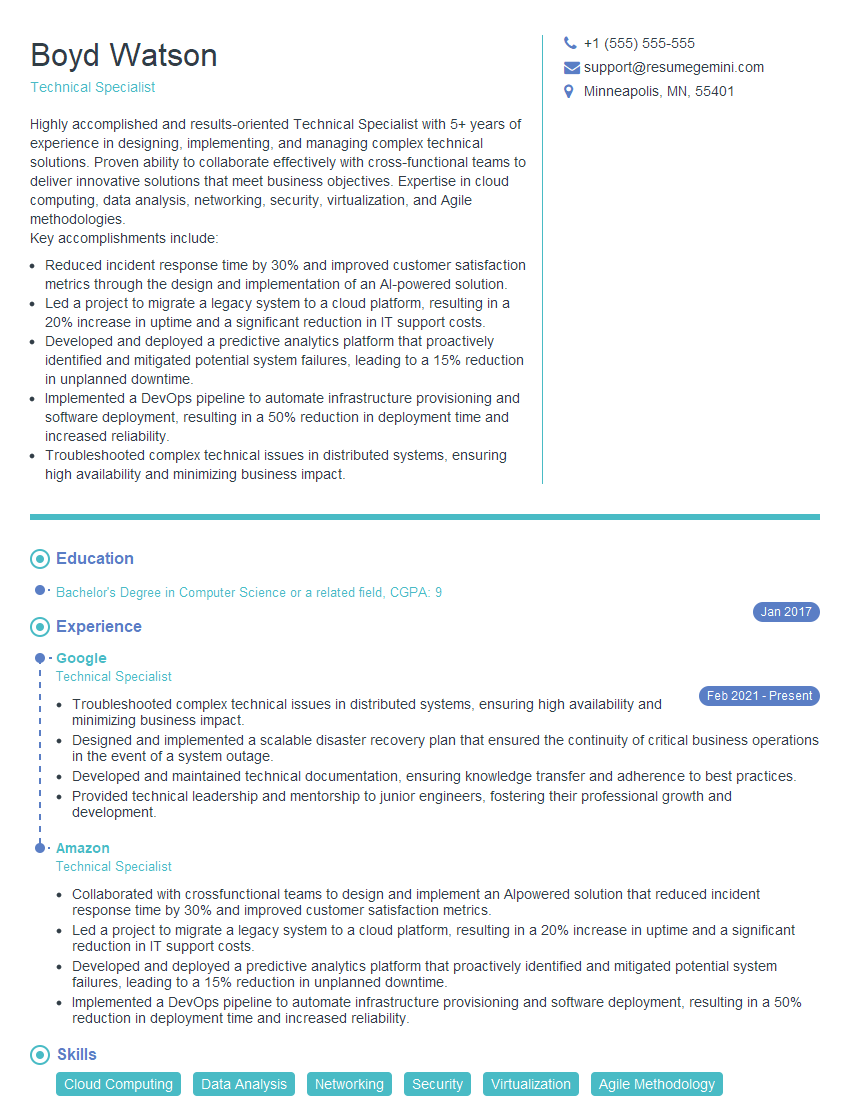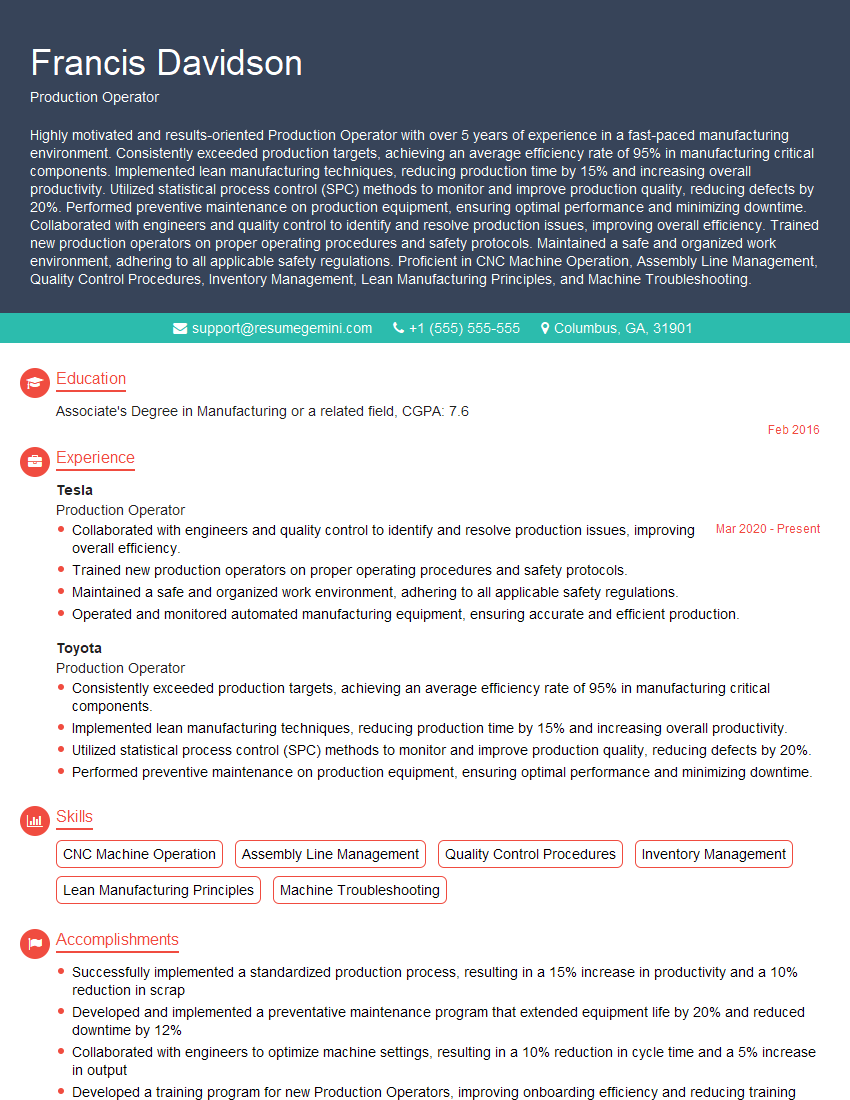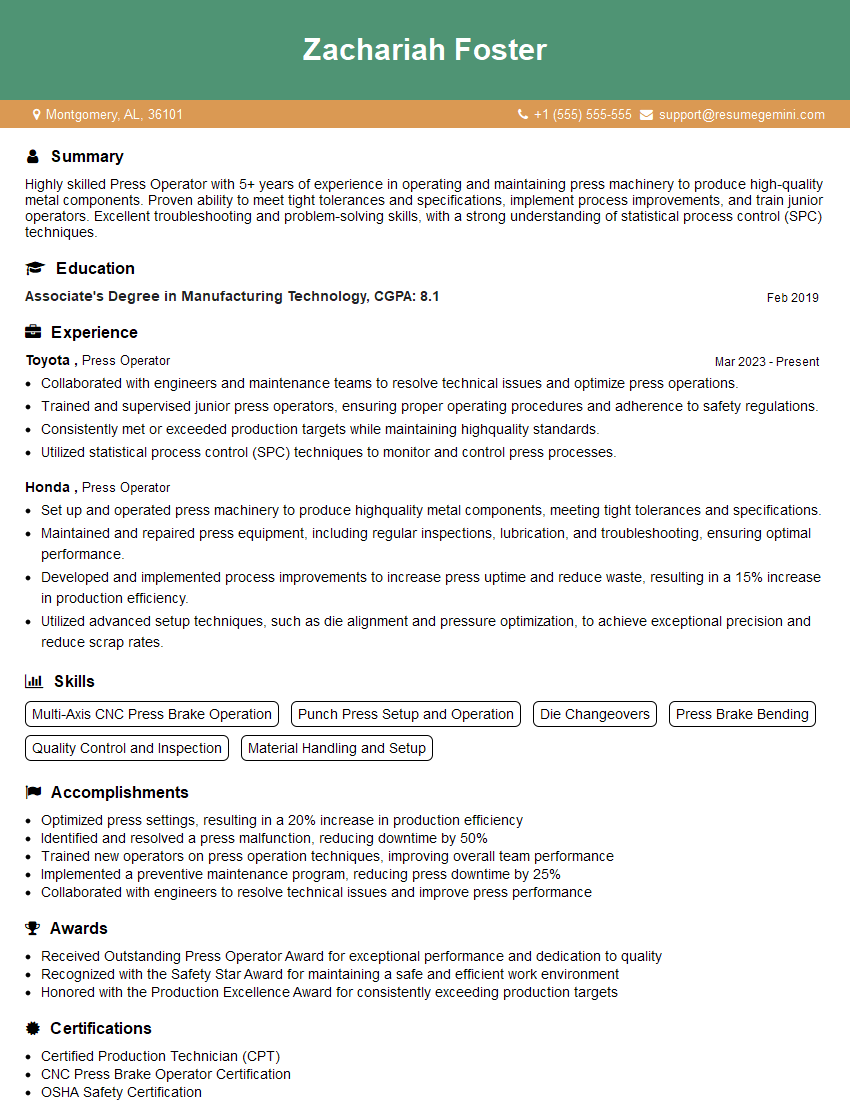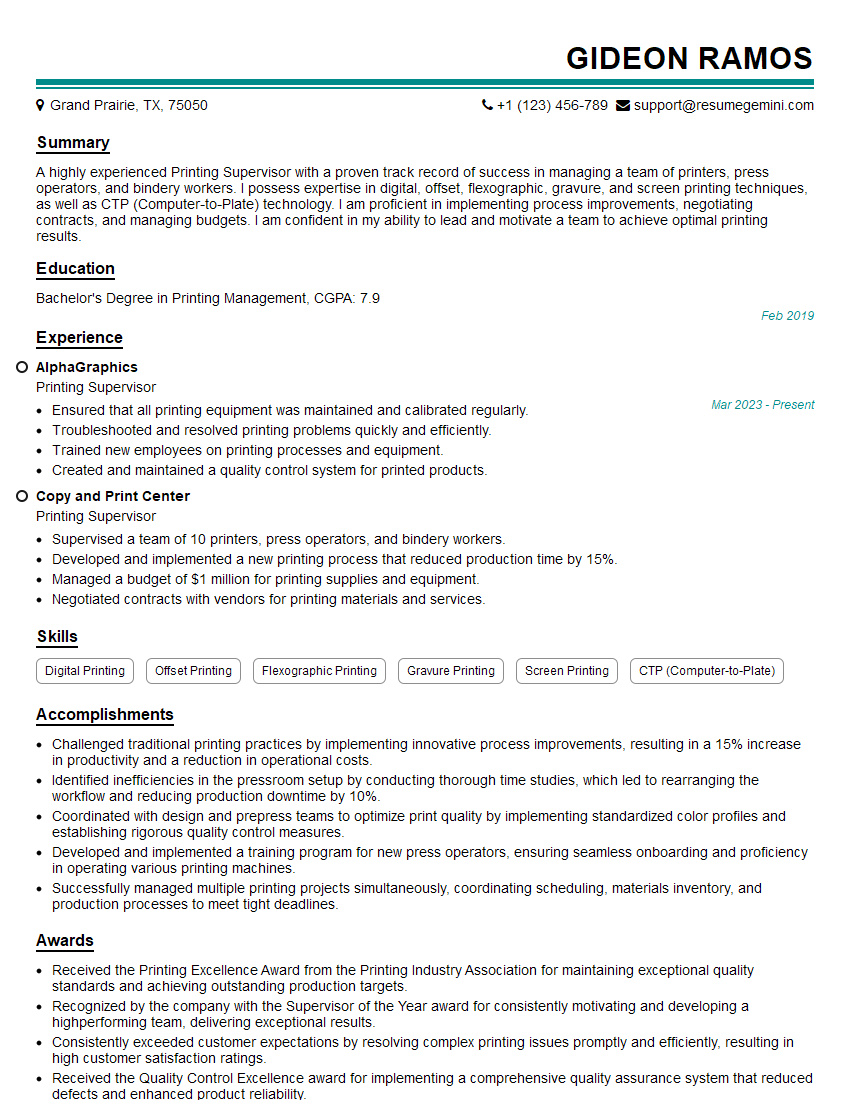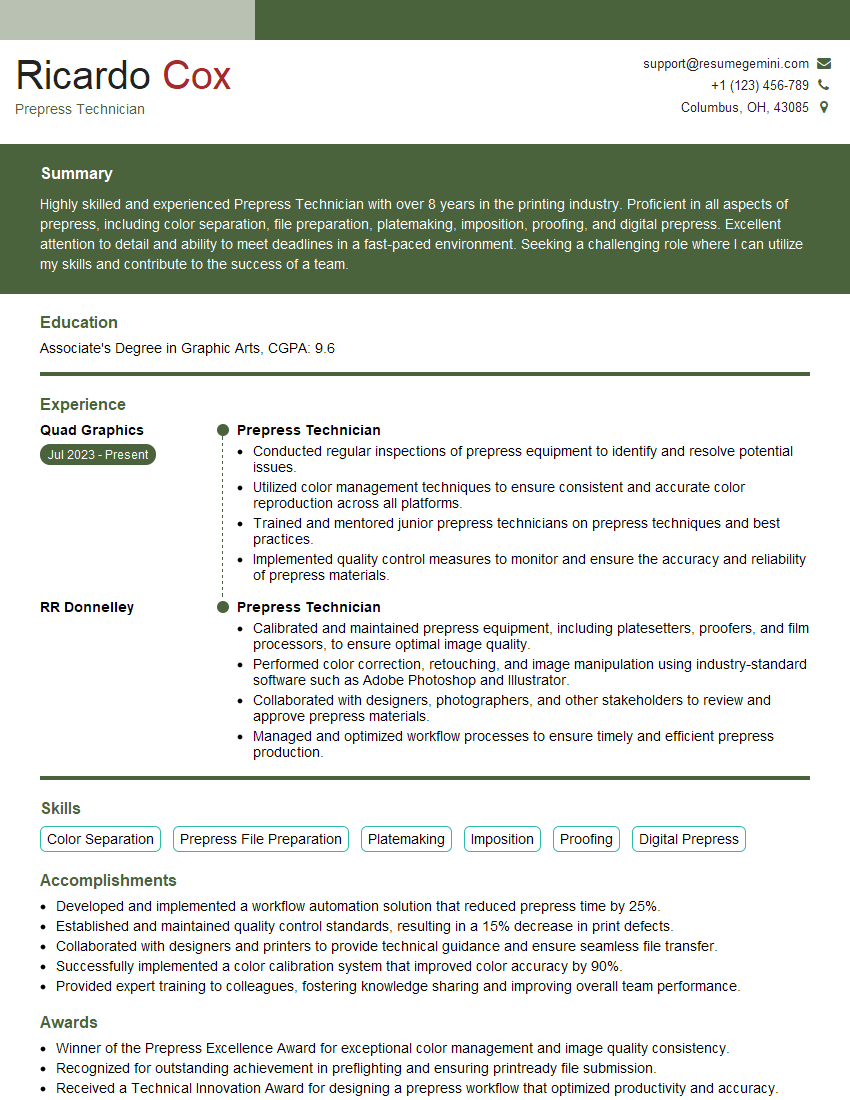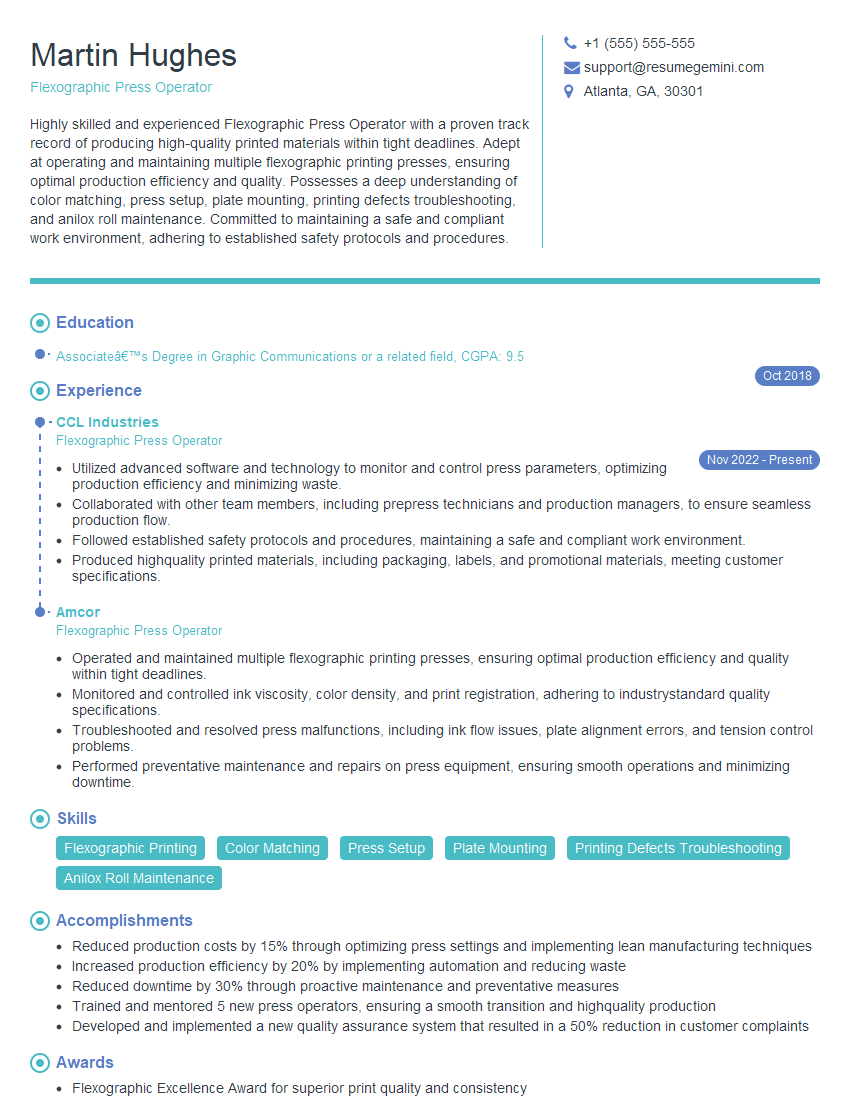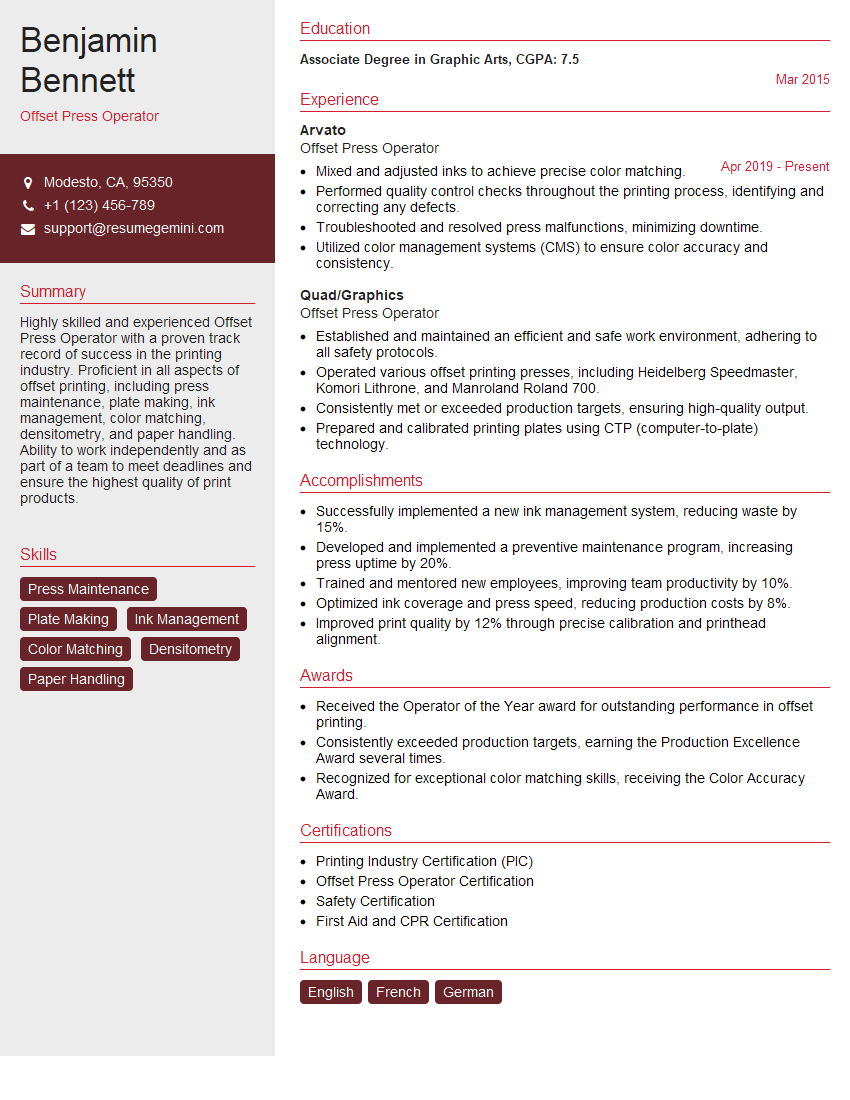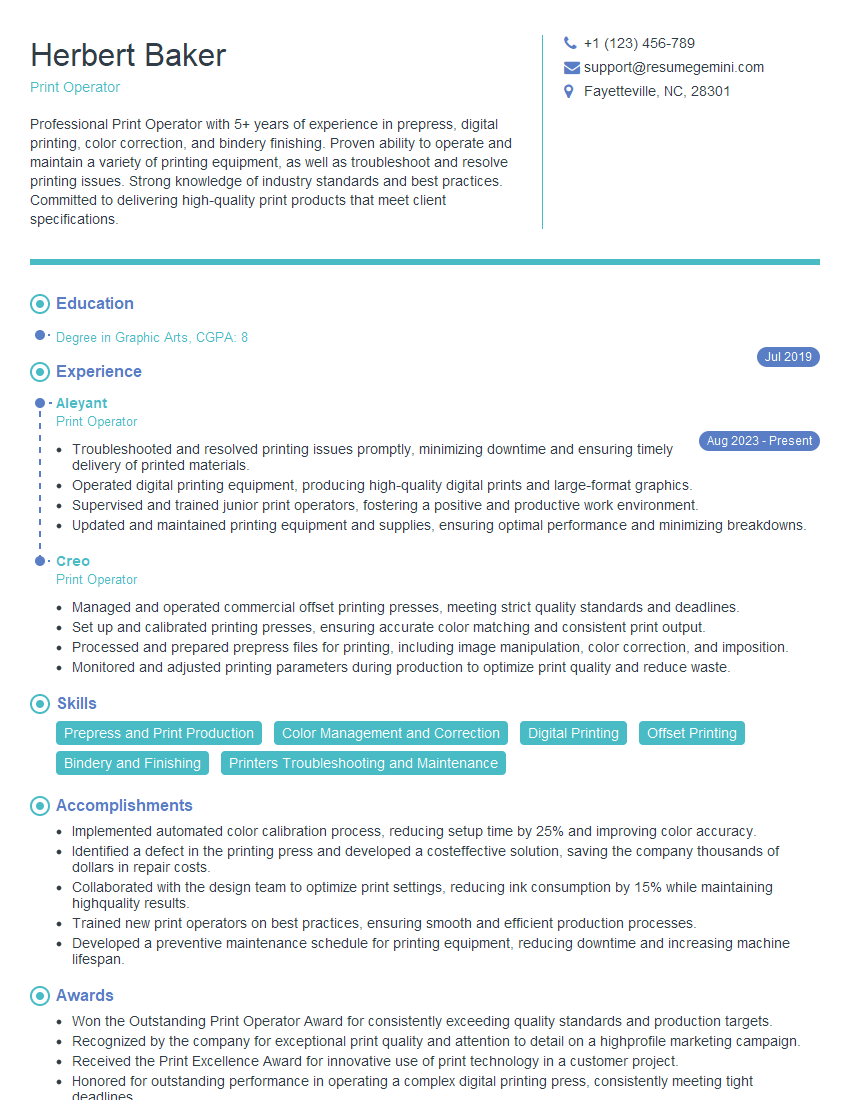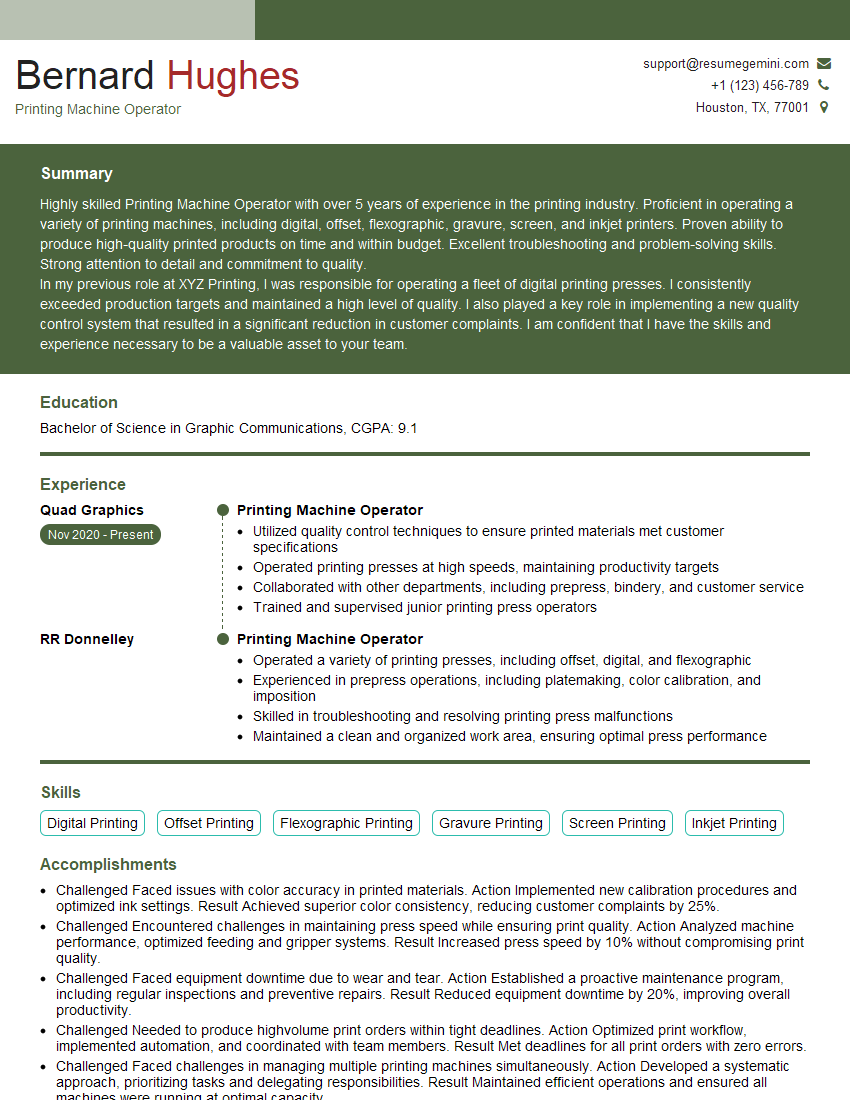Feeling uncertain about what to expect in your upcoming interview? We’ve got you covered! This blog highlights the most important Mark Andy 2200 interview questions and provides actionable advice to help you stand out as the ideal candidate. Let’s pave the way for your success.
Questions Asked in Mark Andy 2200 Interview
Q 1. Describe your experience operating a Mark Andy 2200 press.
My experience with the Mark Andy 2200 spans over five years, encompassing a wide range of print jobs, from simple label runs to complex multi-color projects with intricate designs. I’m proficient in all aspects of operation, from pre-press setup to post-press finishing, and comfortable handling various substrates and inks. I’ve consistently achieved high-quality output while meeting tight deadlines. For example, I once managed a last-minute rush order for a major client requiring a high-volume, intricate label design. By optimizing the press settings and collaborating effectively with the pre-press team, we successfully delivered the job on time and to the client’s satisfaction, exceeding their expectations for quality and turnaround time.
Q 2. Explain the setup process for a typical job on the Mark Andy 2200.
Setting up a job on the Mark Andy 2200 involves a systematic approach. First, I verify the job specifications, including the substrate, inks, design, and quantity. Then, I prepare the press by installing the correct anilox rollers and doctor blades, ensuring they are clean and in good working condition. Next, I load the substrate, aligning it accurately and adjusting the tension to prevent wrinkles or breaks. I then proceed with ink loading, meticulously following the color profiles and ensuring consistent ink viscosity. After initial setup, I run a test print, carefully examining the register, color accuracy, and overall print quality. Fine adjustments are made to the impression pressure, ink density, and web tension until a perfect print is obtained before commencing full production. For instance, with a job requiring Pantone matching, I carefully calibrated the ink using a spectrophotometer, ensuring precise color consistency throughout the run.
Q 3. How do you troubleshoot common printing defects on the Mark Andy 2200?
Troubleshooting printing defects on the Mark Andy 2200 requires a methodical approach. I start by identifying the nature of the defect, such as banding, slurring, poor register, or color inconsistencies. Then I systematically investigate potential causes. For banding, I might check the anilox roller for wear or cleaning issues; for slurring, I’d examine the impression rollers or ink viscosity. Poor register often points to issues with web tension, or the unwind/rewind systems. Color inconsistencies can stem from improper ink mixing, worn anilox rollers, or issues with the ink metering system. I use the press’s diagnostic tools and my knowledge of the machine to pinpoint the root cause, often making adjustments to pressure, speed, or ink flow to resolve the problem. For example, once I solved a recurring banding issue by simply replacing a worn doctor blade. The methodical elimination process, combined with a keen eye for detail, ensures swift and efficient problem resolution.
Q 4. What are the key safety procedures you follow when operating a Mark Andy 2200?
Safety is paramount when operating the Mark Andy 2200. Before starting any work, I ensure all safety guards are in place and functioning correctly. I always wear appropriate personal protective equipment (PPE), including safety glasses, gloves, and hearing protection. I regularly inspect the press for any signs of damage or malfunction, and I never attempt any repairs or adjustments unless properly trained to do so. I adhere strictly to lockout/tagout procedures whenever working on moving parts. I maintain a clean and organized work area to prevent accidents, and I’m always mindful of potential hazards like moving rollers, hot surfaces, and ink spills. Following a strict safety protocol helps prevent injuries and ensures a safe working environment for myself and others.
Q 5. Explain the different types of anilox rollers and their applications on the Mark Andy 2200.
Anilox rollers are crucial for consistent ink transfer on the Mark Andy 2200. Different types are used depending on the printing application. Ceramic anilox rollers offer high durability and consistent ink transfer, ideal for long runs and high-volume jobs. Chromatic anilox rollers are generally less expensive but may wear faster. There are also variations in cell geometry (e.g., tri-helical, hexagonal) which affect the ink transfer. The Line Screen is critical; a higher line screen generally results in a finer image but with less ink volume. The choice of anilox roller depends on the ink viscosity, substrate, and desired print quality. For instance, a fine-line screen ceramic roller might be used for high-resolution printing on thin substrates, while a coarser screen chrome-plated roller might be suitable for a less detail-oriented print on thicker materials. Careful selection ensures optimal ink transfer and consistent print quality throughout the entire print run.
Q 6. How do you maintain the ink and cleaning systems on the Mark Andy 2200?
Maintaining the ink and cleaning systems is crucial for optimal press performance and print quality. I always follow the manufacturer’s recommendations for ink storage, handling, and cleaning. After each print run, I thoroughly clean the ink system, including the ink ducts, pumps, and rollers, using appropriate solvents and cleaning agents. Regular maintenance prevents ink clogging and ensures consistent color accuracy. I also keep a detailed log of ink usage and cleaning procedures. This preventative maintenance minimizes downtime, extends the lifespan of the press components, and ultimately contributes to a cost-effective and efficient print production process. For example, I’ve found that a diligent cleaning schedule reduces the frequency of unexpected ink related delays.
Q 7. Describe your experience with register adjustments on the Mark Andy 2200.
Register adjustments on the Mark Andy 2200 require precision and patience. I use the press’s controls to finely adjust the position of each printing unit to achieve perfect alignment between colors. This involves making small incremental adjustments to the lateral and longitudinal positions of the print units. I utilize test prints and a magnifying glass to check the register meticulously, ensuring each color is accurately aligned with the previous one. The process often involves iterative adjustments, carefully monitoring the alignment until a precise register is achieved. Experience and a keen eye for detail are essential in this aspect. For example, I recently corrected a register problem on a multi-color job by making minor adjustments to the lateral position of one printing unit, resulting in significantly improved print quality.
Q 8. How do you manage waste and ensure efficient material usage on the Mark Andy 2200?
Waste management on the Mark Andy 2200 is crucial for both profitability and environmental responsibility. We employ a multi-pronged approach. Firstly, meticulous pre-press preparation minimizes errors leading to fewer material re-runs. This includes carefully checking the artwork, ensuring accurate die-cutting registration marks, and performing test runs with minimal waste. Secondly, we optimize the web path, ensuring minimal material is used for each job. This involves careful adjustment of the unwind and rewind tension to minimize stretching and breakage. Finally, we diligently collect and separate waste materials—ink, substrates, and packaging—for proper recycling and disposal according to environmental regulations. We even track waste generation per job to identify areas for improvement and cost savings. For instance, on a recent job printing labels, we reduced waste by 15% by fine-tuning the web path adjustments after analyzing the waste data from previous runs. This directly translated to a significant cost reduction.
Q 9. What are the different types of substrates you have worked with on the Mark Andy 2200?
My experience with the Mark Andy 2200 spans a wide range of substrates. I’ve worked extensively with paper-based materials, including various coated and uncoated papers, self-adhesive labels, and specialty papers like textured or metallic stocks. I’ve also handled various film substrates, such as polyethylene (PE), polypropylene (PP), and polyester (PET) films, commonly used for flexible packaging and pressure-sensitive labels. Furthermore, I have experience with composite materials like paper-foil laminates and other specialty substrates requiring specific handling and printing parameters. The ability to adapt to different substrates is essential for versatility on the Mark Andy 2200, and understanding the specific properties of each substrate (e.g., absorbency, tensile strength) is key to achieving optimal print quality and avoiding problems.
Q 10. Describe your experience with pre-press preparation for the Mark Andy 2200.
Pre-press preparation for the Mark Andy 2200 is critical for a smooth and efficient printing process. My process begins with verifying the artwork’s resolution, color accuracy, and overall design specifications. Then, I carefully check the imposition and create color separations if necessary, ensuring correct registration marks for accurate cutting and finishing. We also create proofing samples to review color accuracy and make adjustments before starting the full production run. This step is crucial because correcting errors during the run is time-consuming and wasteful. Software like Adobe Illustrator and Photoshop are vital tools for this stage. For example, I once caught a subtle color mismatch in a design during the proofing stage, preventing a costly reprint of thousands of labels. This proactive approach saves time and resources.
Q 11. How do you conduct quality checks during and after a printing run on the Mark Andy 2200?
Quality control is an ongoing process during and after each printing run. During the run, I regularly inspect the printed output for color consistency, registration accuracy, and print quality using a densitometer and magnifying glass. I also check for any defects like missing or blurry images, misaligned colors, and web breaks. After the run, a more thorough inspection is conducted, focusing on the overall print quality, color accuracy against the proof, and ensuring the correct number of printed pieces. We use statistical process control (SPC) charts to monitor and analyze print quality data to identify trends and potential problems proactively. For instance, if we notice a slight color shift over time, we can adjust the ink settings accordingly to maintain consistency throughout the entire job.
Q 12. What are the common causes of web breaks on the Mark Andy 2200 and how do you address them?
Web breaks on the Mark Andy 2200 can be frustrating but are often caused by predictable issues. Common culprits include improper web tension, defects in the substrate material (e.g., pinholes, weak areas), incorrect setup of the rollers, and build-up of dust or debris on the rollers. Troubleshooting involves systematically checking each component. I start by checking the tension settings on both the unwind and rewind stands. Then, I examine the rollers for any damage or debris. Finally, I check the substrate for defects. If a defect is found in the substrate, I work with the supplier to address the issue. For example, a recent web break was traced to a buildup of static electricity. We addressed this by installing an anti-static bar, resolving the recurring issue.
Q 13. Explain your understanding of the different printing units on the Mark Andy 2200.
The Mark Andy 2200 typically features several printing units, often configured according to the customer’s requirements. These units can include flexographic printing units, which utilize flexible plates and are widely used for high-volume label printing; UV curing units, which cure the ink instantly using ultraviolet light; and sometimes screen printing units, ideal for certain effects. Each unit has specific rollers and adjustments for ink transfer and registration. Understanding the functionality and interaction between these units is crucial for optimal print quality. For instance, the precise adjustment of the anilox roller in a flexographic unit directly impacts the ink density. We use these settings in tandem with the print quality checks mentioned earlier to achieve consistent results across runs.
Q 14. How do you perform color adjustments and maintain color consistency on the Mark Andy 2200?
Maintaining color consistency on the Mark Andy 2200 is achieved through a combination of precise adjustments and rigorous quality control. We use a densitometer to measure ink density and make adjustments to ink settings to match the target colors. Color management software helps to standardize and ensure consistency across different jobs. Regular calibration of the press and careful monitoring of ink viscosity and temperature are essential. Addressing environmental factors like temperature and humidity in the printing room also contributes to consistent color reproduction. Furthermore, we maintain a detailed color profile for each ink and substrate combination to ensure repeatability for future jobs. We constantly monitor color throughout a run using color charts, and this approach is paramount to minimizing costly reprints due to off-color outputs.
Q 15. Describe your experience with different drying systems on the Mark Andy 2200.
My experience with drying systems on the Mark Andy 2200 encompasses several types, each suited to different ink and substrate combinations. The most common are:
- Hot Air Drying: This is a standard system using heated air to evaporate the solvent or water from the ink. I’ve extensively used this method, adjusting air temperature and airflow based on ink viscosity, substrate type (e.g., paper, film), and print speed to achieve optimal drying. For instance, thicker inks and slower speeds might necessitate higher temperatures, while thinner inks on porous substrates require careful control to prevent over-drying and wrinkling.
- UV (Ultraviolet) Curing: For UV inks, the 2200 can be equipped with UV curing units. I have extensive experience optimizing UV lamp intensity and conveyor speed to ensure complete cure, which is critical for achieving scratch and rub resistance. Incorrect settings here can lead to incomplete curing, resulting in smudging or adhesion issues.
- Hybrid Systems: Some installations combine hot air and UV curing, utilizing hot air for initial drying and UV for final curing, especially useful with inks requiring both methods for complete curing and adhesion.
Selecting the appropriate drying system and fine-tuning its parameters is critical for print quality and production efficiency. Improper drying can lead to print defects such as smearing, offsetting, and adhesion problems, impacting overall job quality.
Career Expert Tips:
- Ace those interviews! Prepare effectively by reviewing the Top 50 Most Common Interview Questions on ResumeGemini.
- Navigate your job search with confidence! Explore a wide range of Career Tips on ResumeGemini. Learn about common challenges and recommendations to overcome them.
- Craft the perfect resume! Master the Art of Resume Writing with ResumeGemini’s guide. Showcase your unique qualifications and achievements effectively.
- Don’t miss out on holiday savings! Build your dream resume with ResumeGemini’s ATS optimized templates.
Q 16. How do you troubleshoot and resolve issues related to impression pressure on the Mark Andy 2200?
Troubleshooting impression pressure issues on the Mark Andy 2200 requires a systematic approach. I begin by visually inspecting the printing units for any obvious problems such as worn or damaged plates, rollers, or blankets.
- Incorrect Pressure Setting: I verify the impression pressure settings are correct for the substrate and ink being used. Incorrect pressure can lead to light or heavy impressions, or even damage to the substrate. The process usually involves adjusting the pressure gauge on the printing unit until the desired impression is achieved.
- Roller and Cylinder Condition: I check the condition of the impression rollers and cylinders. Worn or damaged rollers can cause inconsistent impression pressure. This may require cleaning, regrinding, or replacement of these components.
- Plate Condition: I inspect the printing plates for wear, damage, or improper mounting. Worn or damaged plates result in poor print quality and uneven impression. This may necessitate replacing or remounting the plates.
- Substrate Issues: Occasionally, the problem lies with the substrate itself. For example, inconsistencies in the substrate thickness can lead to uneven impression. In such cases, a different batch of substrate is tested.
In many cases, a combination of these factors is at play. Using a methodical, elimination-based approach, coupled with my experience, quickly identifies and rectifies the source of the problem, minimizing downtime.
Q 17. What is your experience with the Mark Andy 2200’s control system and its functionalities?
The Mark Andy 2200’s control system is intuitive yet powerful. I’m proficient in operating the system, including setting up jobs, managing parameters, and troubleshooting errors. The functionalities I utilize regularly include:
- Job Setup: Programming job parameters such as print length, repeat length, number of colors, and drying settings. This ensures the press runs according to the specifications of the job.
- Parameter Adjustments: In real-time adjustments of various parameters, such as ink flow, impression pressure, and web tension, during print runs to maintain consistent print quality.
- Diagnostic Tools: Utilizing the built-in diagnostics to identify and resolve problems relating to the press’s different modules and components. For example, error codes are analysed and troubleshooting steps are executed to resolve the issue.
- Automation Features: My experience includes using various automation features to enhance the efficiency of the press, reducing setup time and increasing throughput.
Familiarity with the control system minimizes setup time, and the diagnostic tools are instrumental in minimizing downtime due to unexpected issues. I view proficiency in using the control system as essential to maximizing productivity and print quality.
Q 18. Describe your experience with different types of inks used on the Mark Andy 2200.
My experience on the Mark Andy 2200 covers a wide range of inks, each with its own unique properties and requirements:
- Water-Based Inks: These are environmentally friendly and offer excellent color vibrancy. Experience here includes managing their viscosity, ensuring proper drying, and understanding their limitations regarding certain substrates.
- Solvent-Based Inks: These offer excellent adhesion and durability but require careful handling due to their volatile nature. I am adept at handling the specific safety procedures related to these inks, ensuring proper ventilation and waste disposal.
- UV (Ultraviolet) Curable Inks: I’m highly experienced with UV inks which provide excellent scratch and rub resistance, quick curing, and vibrant colors. My expertise includes managing the proper intensity of UV lamps and ensuring complete curing to avoid smudging or adhesion problems.
- Flexographic Inks: A staple in my work. Understanding the nuances of each ink type and their interactions with the various press components is critical for consistent results and achieving the desired color accuracy.
Selecting the right ink is essential for the intended application. Choosing the wrong type of ink, or improperly managing its properties, directly impacts the final product’s quality and longevity. This expertise ensures minimal waste and optimal print quality.
Q 19. How do you manage and maintain the different rollers and cylinders on the Mark Andy 2200?
Maintaining rollers and cylinders on the Mark Andy 2200 is crucial for consistent print quality and press longevity. This involves a multi-faceted approach:
- Regular Cleaning: Daily cleaning of all rollers and cylinders is essential to remove ink build-up and debris. This prevents ink transfer issues and maintains consistent impression.
- Periodic Inspection: I regularly inspect rollers and cylinders for wear, damage, or other defects. This proactive approach allows me to replace or repair damaged components before they cause major problems.
- Proper Storage: When not in use, rollers and cylinders are properly stored to prevent damage or deterioration. This ensures the longevity of these components.
- Specialized Cleaning: For specific cleaning requirements I use specialized cleaning solutions and techniques appropriate for the type of roller and the ink being used. This ensures that the cleaning is effective without damaging the components.
- Grinding and Repolishing: When necessary, I arrange for the grinding and repolishing of worn rollers and cylinders to restore their original surface condition. This extends their lifespan and maintains consistent print quality.
A well-maintained press minimizes downtime and ensures consistent print quality. Neglecting this maintenance can lead to significant issues including poor print quality, press downtime, and costly repairs.
Q 20. Explain your understanding of the relationship between anilox volume and ink density.
The relationship between anilox volume (measured in lines per inch (lpi) and cubic centimeters per square meter (BCM)) and ink density is directly proportional. Anilox rollers have tiny cells engraved into their surface. The volume of these cells dictates the amount of ink they can hold and transfer to the printing plate. A higher anilox volume means a greater ink volume is transferred resulting in higher ink density on the substrate. Conversely, a lower anilox volume results in lower ink density.
For example, a high-volume anilox (e.g., 7 BCM) will deposit more ink, leading to a denser, richer print, while a low-volume anilox (e.g., 2 BCM) will result in a lighter print. Choosing the right anilox volume is critical for achieving the desired ink density, color vibrancy, and overall print quality. Incorrect anilox volume can lead to either very light or very heavy prints, affecting overall job aesthetics and efficiency.
Consider substrate absorbency too. A highly porous substrate will absorb more ink than a non-porous one, thus affecting the final ink density even with a fixed anilox volume. Thus, careful consideration must be given to both anilox volume and substrate characteristics when optimizing for ink density.
Q 21. How do you ensure the accurate cutting and slitting of the printed material on the Mark Andy 2200?
Accurate cutting and slitting on the Mark Andy 2200 is vital for delivering finished products to specification. This requires precision in setup and maintenance:
- Blade Sharpening: Maintaining sharp cutting blades is crucial. Dull blades lead to ragged edges, inconsistencies in cut length, and increased risk of damage to the printed material. Regular sharpening and/or replacement is essential.
- Die Setup: Accurate die setup is fundamental. The die must be precisely aligned to ensure accurate cuts and slitting. This involves careful adjustments to ensure the die is properly positioned and clamped securely.
- Web Tension Control: Maintaining consistent web tension is essential for accurate cutting. Fluctuations in web tension can lead to inaccurate cuts and waste material.
- Regular Calibration: Regular calibration of the cutting and slitting mechanisms ensures accuracy and precision. This involves adjusting the settings of the cutting and slitting mechanisms based on the material’s characteristics and the desired cut dimensions.
- Material Handling: Proper handling and feeding of the printed material is important in preventing misalignment and damage, ensuring accurate cutting.
Inaccurate cutting not only impacts the appearance of the final product but also wastes material and can lead to production downtime. My experience ensures that the press is set up precisely and that regular maintenance is performed to guarantee accurate cutting and slitting, optimizing efficiency and minimizing waste.
Q 22. Describe your experience with the die cutting unit on the Mark Andy 2200.
The die-cutting unit on the Mark Andy 2200 is a crucial component for post-print finishing. It allows for precise cutting of labels and other printed materials into various shapes and sizes. My experience encompasses setting up and operating the unit, including adjusting the die pressure, ensuring proper registration, and troubleshooting issues such as mis-cuts or scoring problems. This involves understanding the different types of die-cutting plates (magnetic, rule, etc.) and their respective maintenance requirements. I’ve worked extensively with both rotary and flatbed die-cutting configurations, adapting my techniques based on the specific job requirements and material properties. For example, I once had to adjust the pressure on a magnetic die to prevent cracking on a particularly delicate substrate. By carefully monitoring the pressure and making incremental adjustments, I was able to achieve perfect cuts without compromising the material’s integrity.
The process also includes meticulous attention to detail regarding die placement and ensuring proper alignment with the printed image. Proper setup minimizes waste and maximizes production efficiency. I’m adept at detecting and resolving issues like inconsistent cuts or damage to the die caused by improper handling or excessive pressure.
Q 23. How do you conduct preventative maintenance on the Mark Andy 2200?
Preventative maintenance on a Mark Andy 2200 is crucial for ensuring consistent print quality and minimizing downtime. My routine includes a daily check of all moving parts, lubricating appropriate areas as per the manufacturer’s guidelines, inspecting the rollers and cleaning them regularly, and meticulously checking the tension of all web paths. This ensures the smooth flow of materials throughout the printing process.
Beyond the daily checks, I perform more in-depth preventative maintenance at regular intervals, including thorough cleaning of the anilox rollers (often using appropriate solvents and brushes), inspecting the doctor blades for wear and tear, and changing them when necessary. I carefully check the condition of the impression cylinders and ensure proper alignment. Proper maintenance also includes examining electrical components for wear or loose connections and the periodic cleaning of the air system to prevent build-up of dust and debris. Thinking proactively, I’ve created a detailed checklist to track these maintenance tasks, ensuring nothing is overlooked.
Q 24. What are some common issues you have encountered while operating the Mark Andy 2200, and how did you resolve them?
During my time operating the Mark Andy 2200, I’ve encountered various issues. One common problem is registration issues, where the printed image doesn’t align perfectly with the die-cut or other print elements. This can stem from several factors, including incorrect web tension, worn impression cylinders, or improper plate mounting. My approach is systematic: I start by checking the web tension, followed by a thorough inspection of the cylinders and plates. Once the root cause is identified (e.g., a slightly worn impression cylinder), I take the necessary corrective action—this may involve adjusting tension, cleaning or replacing parts, or even realigning the entire printing unit.
Another frequent issue is color inconsistencies. This could be due to problems with ink viscosity, anilox roller wear, or ink metering issues. I have experience troubleshooting these through a process of elimination, checking ink viscosity with a viscosity cup, inspecting anilox rollers for wear, and cleaning or replacing them if necessary. I often consult the press’s troubleshooting guides and collaborate with the printing team to isolate the problem quickly and efficiently.
Q 25. How familiar are you with the different types of flexographic plates used on the Mark Andy 2200?
I am very familiar with various flexographic plates used on the Mark Andy 2200. My experience includes working with photopolymer plates (the most common type), offering various durometer (hardness) levels, which are chosen depending on the print run length and substrate being used. Harder plates are typically used for longer runs, while softer plates provide better detail for shorter runs. I also have experience with the use of digital plates, providing flexibility for short-run and variable data printing.
Beyond the material composition, I understand the importance of proper plate mounting and ensuring the plates are clean and free from any defects. Improper plate mounting can lead to registration issues or poor print quality. I meticulously inspect each plate before mounting it onto the cylinder, paying close attention to its condition and ensuring it’s properly secured to avoid issues during the printing process.
Q 26. What is your experience with using different types of adhesives on the Mark Andy 2200?
My experience encompasses working with a variety of adhesives on the Mark Andy 2200, including hot melt adhesives, pressure-sensitive adhesives (PSAs), and water-based adhesives. Each adhesive has unique properties and requires specific handling to achieve optimal results. For instance, hot melt adhesives demand precise temperature control to ensure proper flow and adhesion, while PSAs need careful consideration of their tack and dwell time to maintain adhesion to the substrate. Water-based adhesives require careful management of their viscosity and drying time.
I understand the importance of choosing the right adhesive for the specific application, considering factors like the substrate, the application method, and the required adhesion strength. I regularly monitor the adhesive application process, paying close attention to the evenness of the adhesive coating and ensuring that the correct amount is applied to avoid issues such as uneven bonding or adhesive build-up.
Q 27. How do you handle emergency situations and safety protocols during operation?
Safety is paramount. I am thoroughly trained in all safety protocols associated with operating the Mark Andy 2200. This includes understanding and adhering to lockout/tagout procedures, utilizing appropriate personal protective equipment (PPE) such as safety glasses and hearing protection, and being fully aware of all emergency shut-off procedures. Before starting any work, I conduct a thorough pre-operational check, inspecting the press for any potential hazards. I also follow a strict cleaning and maintenance schedule to prevent potential hazards.
In emergency situations, I am trained to react calmly and decisively, taking immediate action to address any issues and ensuring the safety of myself and my colleagues. This involves initiating the emergency shut-off procedures, assessing the situation, and contacting the appropriate personnel for assistance, following established company emergency protocols. I have undergone safety training, and I regularly review safety procedures to maintain my proficiency and knowledge. For example, I have participated in hands-on training for emergency shutdowns and fire safety procedures.
Q 28. Describe your understanding of the overall printing process and workflow on the Mark Andy 2200.
The printing process on a Mark Andy 2200 involves a complex interplay of several stages. It begins with the preparation of the substrate, ensuring it is properly unwound and fed into the press. Next comes the printing process itself, using flexographic printing techniques, which involves transferring the image from the flexographic plates to the substrate through the precise application of ink. After printing, the die-cutting unit shapes the material, followed by finishing operations such as laminating or varnishing, depending on the job requirements.
The workflow involves a meticulous step-by-step process. First, it starts with the job setup, including preparing the plates, inks, and other consumables. This is followed by the actual printing process, during which I carefully monitor the print quality, registration, and overall efficiency. Then, I ensure that all post-print finishing processes are carried out according to specifications. Finally, there’s the crucial quality inspection process before the finished products are moved to packaging and shipping. Throughout, maintaining the press’s efficiency and productivity is a continuous focus.
Key Topics to Learn for Mark Andy 2200 Interview
- Machine Operation & Setup: Understanding the complete workflow, from initial setup to print production, including web path adjustments and register control.
- Press Controls & Automation: Familiarize yourself with the control panel, automated features, and troubleshooting common operational issues. Be prepared to discuss your experience with pre-press settings and their impact on print quality.
- Print Quality & Troubleshooting: Know how to identify and address common print defects like misregistration, color inconsistencies, and web breaks. Discuss your approach to problem-solving in a high-pressure environment.
- Safety Procedures & Regulations: Demonstrate a strong understanding of all safety protocols associated with operating the Mark Andy 2200. This includes lockout/tagout procedures and proper handling of materials.
- Maintenance & Preventative Maintenance: Discuss your experience with routine maintenance tasks, preventative maintenance schedules, and identifying potential issues before they become major problems. Understanding cleaning procedures and ink/substrate handling is crucial.
- Ink & Substrate Knowledge: Demonstrate familiarity with different ink types, their properties, and compatibility with various substrates. Be prepared to discuss color management and achieving desired print results.
- Job Setup & Changeovers: Explain your experience with efficiently setting up and changing over jobs on the Mark Andy 2200, including optimizing production time and minimizing waste.
- Performance Monitoring & Optimization: Discuss your methods for tracking and improving press performance, such as speed, efficiency, and waste reduction. Understanding key performance indicators (KPIs) is essential.
Next Steps
Mastering the Mark Andy 2200 demonstrates valuable skills highly sought after in the printing industry, significantly enhancing your career prospects. A strong understanding of this press translates to increased earning potential and opens doors to more challenging and rewarding roles. To maximize your chances of landing your dream job, creating an ATS-friendly resume is crucial. This ensures your application gets noticed by recruiters and hiring managers. We highly recommend using ResumeGemini, a trusted resource for building professional and effective resumes. Examples of resumes tailored to the Mark Andy 2200 are available to help you get started.
Explore more articles
Users Rating of Our Blogs
Share Your Experience
We value your feedback! Please rate our content and share your thoughts (optional).
What Readers Say About Our Blog
Hello,
We found issues with your domain’s email setup that may be sending your messages to spam or blocking them completely. InboxShield Mini shows you how to fix it in minutes — no tech skills required.
Scan your domain now for details: https://inboxshield-mini.com/
— Adam @ InboxShield Mini
Reply STOP to unsubscribe
Hi, are you owner of interviewgemini.com? What if I told you I could help you find extra time in your schedule, reconnect with leads you didn’t even realize you missed, and bring in more “I want to work with you” conversations, without increasing your ad spend or hiring a full-time employee?
All with a flexible, budget-friendly service that could easily pay for itself. Sounds good?
Would it be nice to jump on a quick 10-minute call so I can show you exactly how we make this work?
Best,
Hapei
Marketing Director
Hey, I know you’re the owner of interviewgemini.com. I’ll be quick.
Fundraising for your business is tough and time-consuming. We make it easier by guaranteeing two private investor meetings each month, for six months. No demos, no pitch events – just direct introductions to active investors matched to your startup.
If youR17;re raising, this could help you build real momentum. Want me to send more info?
Hi, I represent an SEO company that specialises in getting you AI citations and higher rankings on Google. I’d like to offer you a 100% free SEO audit for your website. Would you be interested?
Hi, I represent an SEO company that specialises in getting you AI citations and higher rankings on Google. I’d like to offer you a 100% free SEO audit for your website. Would you be interested?
good



